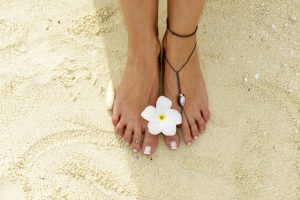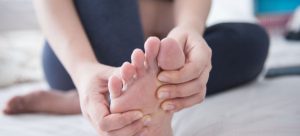When the sun comes out it’s inevitable that your ankles and feet do too.

Why do my ankles and feet swell in hot weather?
This phenomenon is actually a result of your body’s natural cooling mechanism. When you are too hot your veins dilate (expand), allowing fluids to leak into surrounding tissues. However, when this happens your veins struggle to pump blood back to the heart and have trouble fighting gravity, which pulls fluid down to the ankles and feet, causing it to pool, resulting in swelling and discomfort.
What can make this problem worse?
Swollen ankles and feet can be exacerbated by a number of factors including:
- Too much salt in your diet. This causes a salt:water imbalance which the body tries to correct by retaining extra water.
- Prolonged sitting or standing. As we walk, the movement of our legs helps to pump blood up from the lower limbs. However, sitting or standing still means that your body has to work harder to pump blood against gravity.
- Age. As we age our circulation can become slower and our hearts can become less efficient at pumping blood around the body. This makes it easier for fluids to pool in the lower limbs.
- Pregnancy. Pregnancy already puts extra strain on the vascular system, as the body has to deal with an increase in fluids as well as an increase in weight.
10 natural ways to ease swollen feet and ankles in warm weather
If your swelling is being caused by heat there are many natural ways you can help cool down your lower limbs and help return fluid to your blood vessels, including:
1. Elevate your feet
If you feet and ankles are swollen, this is one of the first things you should do to help reduce the swelling. Gravity really isn’t your friend when it comes to swelling, so you need to reverse its effect on your limbs by making sure you elevate you feet as much as possible.
2. Avoid heat as much as possible
If you are prone to swelling when it is warm, try to stay a cool as possible. Easier said than done sometimes, but one way to do this is to ensure you don’t sit in direct sunlight. Find shaded areas to sit in or seek out air conditioned rooms where possible.
Avoid excessively hot baths, hot showers and saunas as these can worsen swelling. Try to keep your water temperature warm but not too hot, and at the end of a shower a good tip is to blast your legs with a jet of cold water to boost circulation.
3. Stay active
Although excessive and intense exercise or activity can contribute to swelling in the lower limbs, gentle exercise such as walking and swimming is good for you as it helps to boost your circulation and get fluid build up flowing again. Exercise at cooler times of the day, such as the morning or early evening.
4. Drink plenty of water
 Whatever you do, don’t limit the amount of water you drink thinking this will lessen the amount of water you retain. Not drinking enough water can make the salt concentration in your blood to go up, which makes your body retain any water you do drink and cause swelling! Excess salt is a big contributor to swelling, so by drinking more water you can help to dilute the amount of salt in your system and flush it out.
Whatever you do, don’t limit the amount of water you drink thinking this will lessen the amount of water you retain. Not drinking enough water can make the salt concentration in your blood to go up, which makes your body retain any water you do drink and cause swelling! Excess salt is a big contributor to swelling, so by drinking more water you can help to dilute the amount of salt in your system and flush it out.
Try to aim for at least 8-10 glasses of plain water a day. If you struggle to drink plain water then try adding slices of cucumber and lemon to it. This not only makes a refreshing drink, but cucumbers and lemons are also great for fighting the swell due to their anti-inflammatory properties. Tasty and powerful!
5. Watch your diet
As I have mentioned, one of the main causes of swelling is excessive salt, so you need to be mindful of how much you consume in your diet. To limit your chances of swollen ankles and feet it is best to pass on the table salt and look at a low-sodium alternative or reduced salt varieties of foods which are usually high in salt, such as soups, sauces, crisps and smoked meats. Try to avoid eating highly processed foods as these often have a high salt content.
6. Support your legs, ankles and feet
Support tights or compression socks can help prevent swelling. They may be a little difficult to get on, but their tightness is key! They provide measured pressure to reduce the size of dilated veins, increase blood flow and help to prevent the pooling of fluids in ankles and feet, which causes swelling.
7. Avoid being stationary for too long
After a long day at work, especially if you have been sitting or standing all day, it is normal to have some swelling in your legs, ankles and feet, since gravity has been at work all day.
One way to avoid this is to ensure you have regular ‘walking breaks’ to ease discomfort and get fluid moving and blood flowing upwards again. If you sit at a desk all day long, try finding a way of propping your feet up – even a slight rise can make a big difference to your swelling.
Try not to sit with your legs crossed as this can restrict blood flow and make swelling worse. It’s best to sit with your feet flat on the floor or crossed at the ankles.
8. Massage/Reflexology (my favourite!)
Massaging your feet and ankles is a good way to get fluid moving and reduce swelling. The best way to do this is by massaging gently, using both hands and working upwards from feet to knees in a circular motion. Or better yet get someone else to massage them for you, as this ensures that you don’t bend your knee and restrict flow.
Essential oils such as peppermint oil and grapefruit oil mixed with a carrier oil such as almond oil are great to use when massaging swollen feet and ankles.

9. The power of magnesium
Magnesium is an important mineral for blood circulation so it’s no surprise that a deficiency in the amount of magnesium in the body can often lead to swelling. You can look to your food to increase your magnesium intake by eating more magnesium rich foods including dark leafy greens, such as spinach, kale, nuts and seeds, fish, avocado and bananas.
10. Horse Chestnut gel
Horse Chestnut is a traditional herbal medicine, where the seeds are used to make a gel. This can help tighten the membranes of the blood vessels, encouraging better venous circulation, help reduce swelling and provide cooling relief to legs, ankles and feet.
Other things you can do…
There are many other natural ways that you can ease swelling when it has occurred including applying ice packs to your swollen area, cooling foot soaks with Epsom salts and wrapping your feet and ankles in damp towels.
What else you should be aware of
Although uncomfortable and often embarrassing if your swollen ankles and feet are on show, swelling is usually temporary, unless it is being caused by an underlying health condition. If proper rest, together with these self help treatments don’t reduce swelling or if you have high blood pressure, then it is important to seek medical advice from your doctor as it may be a sign of a more serious health condition.

